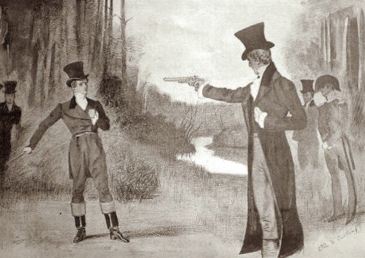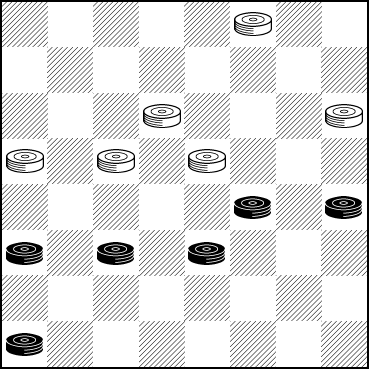The Checker Maven
Jump to navigationA. Jackson, Duelist

Andrew Jackson, seventh President of the United States, certainly wasn't the author of today's Checker School study; President Jackson passed away a good forty years before this position was first formally presented. But did President Jackson play checkers? It's been speculated by historians that he was a chess player, and it seems quite likely that, at the very least, he would have known how to play the game of checkers. But his favorite sport was apparently dueling; he is reported to have participated in some hundred duels!
Fortunately, a checker duel has far fewer permanent consequences than the type of dueling President Jackson did. Let's, for instance, look at the position below.
WHITE

BLACK
Black to Play and Draw
B:W30,23,21,20,19,18:B14,13,12,11,10,4.
"Play and Draw" has little application to dueling (unless you're drawing pistols), as obtaining a draw in a duel isn't the point. But here, getting a draw with the Black pieces represents a respectable achievement. Can you do it? No pistols or swords needed, just good over the board checker skills. Solve the problem and shoot (or stab) your mouse on Read More to see the solution, sample games, and explanatory notes.![]()
Solution
The solution, sample games, and lettered notes are taken from the Ben Boland classic, Famous Positions in the Game of Checkers. Numbered notes are by the Editor, using the KingsRow computer engine.
4-8, 18-9, 11-15, 9-6---1, 15-24, 6-2, 24-28---B, 23-18---2, 8-11, 30-26, 10-15, 26-22, *15-19, 2-6, 19-23, 6-10, 23-26, 10-15, 26-30, 15-8, *28-32, 8-11---C, 32-27, 18-14, 30-25, 22-18, 25-22, 18-15, 22-18, 14-9, 27-23, 15-10, 18-14, 11-15, 14-5---3, 10-7, 5-9, 7-2, 9-5, 2-7, 5-9, 7-11, 9-5, 15-10, 5-9---4. Drawn.
1---20-16 allows for a similar draw.
2---Now if 2-7 then 10-15 and if 7-11 then 15-18! Drawn.
3---One last little way to go wrong: 14-7 15-19 White Wins.
4---White's seemingly superior mobility is illusory, and no progress can be made.
Game: 10-14, 24-19, 11-16, 28-24, 16-20, 19-15, 7-10, 24-19, 9-13, 22-17, 13-22, 25-9, 5-14, 29-25, 3-7, 25-22, 20-24, 27-20, 7-11, 22-18, 1-5, 18-9, 11-27, 32-23, 6-13, 23-18, 10-14, 18-9, 5-14, 26-22---A, 2-7, 31-27, 8-11, 27-23, 7-10, 22-18. Forms above position.
Game: 11-16, 24-19, 8-11, 22-18, 4-8, 25-22, 16-20, 22-17, 9-14, 18-9, 5-14, 30-25, 11-15, 25-22, 15-24, 28-19, 8-11, 22-18, 1-5, 18-9, 5-14, 26-22, 11-15, 27-24, 20-27, 31-24, 6-9, 17-13, 7-11, 13-6, 2-9, 32-28, 9-13, 24-20, 15-24, 28-19, 11-15. Forms above position. colors reversed. A. Jackson.
A---A. Long with White played 26-23 against H. Freyer, in the 10th National Tourney; 26-23, 2-7, 30-26, 13-17, 19-16, 12-19, 23-16, 8-11, 26-22, 17-26, 31-22, 11-15, 22-17, 7-10. Drawn. In the Roseville Citizen, Sept. 28, to Oct. 12, 1939, the critics believed Long missed a win by playing 26-23 instead of 26-22. But later changed their minds, I then pointed out it was the A. Jackson position.
B---Forced; if 24-27, then 2-7, 10-15, 7-11. White Wins.
C---18-15, 30-25---D, 22-18, 25-22, 8-11 (8-4, *32-28 Draws), 32-27, 18-14, 27-23, 14-9, 22-18, 9-5, 23-19. Drawn. Wm. Gardner.
D---32-27, 15-10, 27-23, *8-3, 23-19, 3-7. White Wins. W. Gardner.
The above game by A. Jackson may be found in J. Robertson’s Guide, Bristol, Part 3, 1888. It may also be found as, No.5, Page 52, "Familiar Themes," No. 126 Duffy’s Standard Positions, Part 2, and Kear's Encyclopedia, Page 248, Var. 3.
Editor's Note: Did you see the similarity between this position and last month's Checker School problem? But in checkers, small differences can often mean a great deal.
You can email the Webmaster with comments on this article.
